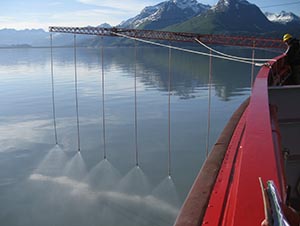
By Joe Banta
Council Project Manager
The Environmental Protection Agency is updating the rules for using chemicals, including dispersants, to respond to oil spills in the United States. This update is intended to address the concerns that arose during and after the BP Deepwater Horizon disaster in 2010. During that disaster, an estimated 210 million gallons of oil was spilled, and over 1.8 million gallons of dispersants were applied to the spill.
Dispersants are chemicals applied to spilled oil to try to break down the oil into small particles with the hope that these particles disperse into the water column rather than remain floating on the surface in a slick.
This spring, the EPA solicited public input on the section of the National Oil and Hazard Substances Pollution Contingency Plan known as “Subpart J.” Subpart J governs the use of dispersants and other chemical and biological agents when responding to oil spills. This section is a catalog of dispersants and other chemical mitigation methods that have been vetted by the EPA to treat oil spills. It also spells out where dispersants can be used, and how much may be used.
This was the first opportunity the council has had in over 20 years to provide input on the national policy governing the use and regulation of dispersants.
“Under the Clean Water Act, the EPA has a fundamental responsibility to prevent the introduction of harmful pollutants into the environment,” said Mark Swanson, executive director of the council. “While the potential and planned use of dispersants in spill response is intended to do more good than harm, the plain truth is dispersants are highly toxic to people and the marine environment. This rule-making and the formal consideration of public comments may be the public’s only opportunity to ensure that the protections we expect from the EPA are actually provided.”
Cautious approach to use of chemicals
One positive change is the EPA’s cautious approach to use of chemicals. Chemicals should only be applied to oil spills when there is clear, science-based evidence that they will be effective and lessen the adverse impacts. The chemicals should also not pose a risk of enhanced toxicity from the treated oil or the agent itself. The council strongly supported this caution, and identified several areas that need clarification to reinforce this critical concept.
Decisions informed by science
The council also strongly supports the EPA’s emphasis on using science when making decisions. However, the council also urged the EPA to acknowledge areas where science on dispersants is uncertain.
Toxicity and chronic effects
EPA has traditionally relied upon a limited set of tests on a few species to establish toxicity data for oil spill treating agents. The proposed changes do not include sufficient testing for a complete understanding of toxicity, particularly for low-level, long-term exposure.
Emphasis on authorizing dispersants before a spill happens
The proposed rule heavily emphasizes a “preauthorization” process. Preauthorization means that dispersants are approved for use before the spill happens. The council expressed support for pre-planning, and encouraged collaboration and rigorous science, but expressed concern that the EPA is over-emphasizing preauthorization at the potential expense of collaborative, case-by-case decision-making.
Next steps
This comment period is closed.The EPA is expected to conduct a second round of public comments before any changes become final, however there is no requirement for additional public review.
For more information, see our post published on 4/14/2015: “EPA wants your comments on proposed changes for using chemical dispersants during oil spills“